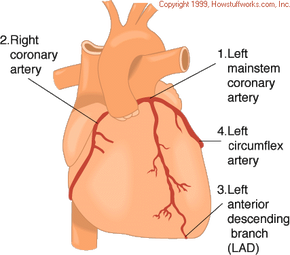Blood Supply
Coronary arteries are the ones that we try to keep clear by eating a healthy diet. If coronary arteries are blocked a heart attack results.
The heart, just like any other organ, requires blood to supply it with oxygen and other nutrients so that it can do its work. The heart does not extract oxygen and other nutrients from the blood flowing inside it -- it gets its blood from coronary arteries that eventually carry blood within the heart muscle. Approximately 4 percent to 5 percent of the blood output of the heart goes to the coronary arteries (7 ½ ounces/minute or 225 ml/min).
Advertisement
There are two main coronary arteries (figure 6) - The left main coronary artery (1) and the right coronary artery (2) which arise from the aorta. The left main coronary artery divides into the left anterior descending branch (3) and the left circumflex arteries (4). Each artery supplies blood to different parts of the heart muscle and the electrical system.
The heart also has veins that collect oxygen-poor blood from the heart muscle. Most of the major veins of the heart (great cardiac vein, small cardiac vein, middle cardiac vein, posterior vein of the left ventricle, and oblique vein of the left atrium) drain into the coronary sinus which opens into the right atrium.
Coronary artery disease is caused by a blockage in one of the coronary arteries. When a coronary artery is partially blocked, that artery cannot supply enough blood to the heart muscle to meet its needs during exertion. When someone with coronary artery disease exerts himself or herself, it causes chest pain. This is due to lack of blood and oxygen to that part of the heart muscle and is called angina. If the obstruction worsens (more frequent angina episodes, with less exertion) a condition called unstable angina can occur. A heart attack happens when a coronary artery is completely blocked and no blood or oxygen is getting to the heart muscle served by that artery. This also causes chest pain and causes death to the heart muscle served by that artery.
For more information on the human heart and related topics, check out the links below.
